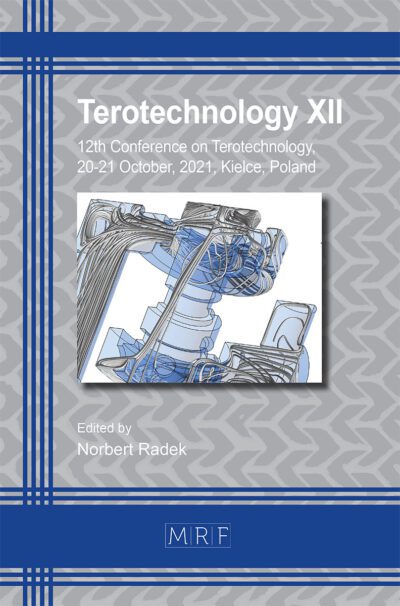Experimental investigation of rotational friction welding for EN AW-6082 – 20MnCr5 joints
Ahmed Dewidar, Alexej Verschinin, Norman Mohnfeld, Hendrik Wester, Sebastian Barton, Hans Jürgen Maier, Johanna Uhe
Abstract. Rotary Friction welding is utilised in various industries, particularly for joining dissimilar materials in mass production, due to its advantages such as minimal material waste, low energy consumption, excellent static and dynamic bond strengths and short production times. This study investigates the effects of process parameters, including friction pressure (80 – 119.4 MPa), friction path (5 – 8 mm), forging pressure (175 – 225 MPa) and forging time (5 – 10 s), on the properties of friction-welded joints between EN AW-6082 and 20MnCr5. Experiments were conducted on cylindrical specimens (Ø 40 mm × 100 mm) using a KUKA Genius Plus RS30. Bond strength was measured using local and global tensile tests. In addition, eddy current testing was employed to investigate its potential in the assessment and prediction of the weld quality of dissimilar RFW joints. The results, analysed using analysis of variance (ANOVA), revealed that higher forging pressures significantly improved bond strength. Moreover, higher values of friction pressure slightly improved bond strength, whereas higher values of friction path negatively influenced it, compared to the respective lower values of the same parameter combination. However, their individual effects were less pronounced compared to forging pressure.
Keywords
Rotary Friction Welding, Bond Strength, Non-Destructive Testing
Published online 5/7/2025, 10 pages
Copyright © 2025 by the author(s)
Published under license by Materials Research Forum LLC., Millersville PA, USA
Citation: Ahmed Dewidar, Alexej Verschinin, Norman Mohnfeld, Hendrik Wester, Sebastian Barton, Hans Jürgen Maier, Johanna Uhe, Experimental investigation of rotational friction welding for EN AW-6082 – 20MnCr5 joints, Materials Research Proceedings, Vol. 54, pp 1479-1488, 2025
DOI: https://doi.org/10.21741/9781644903599-160
The article was published as article 160 of the book Material Forming
![]() Content from this work may be used under the terms of the Creative Commons Attribution 3.0 license. Any further distribution of this work must maintain attribution to the author(s) and the title of the work, journal citation and DOI.
Content from this work may be used under the terms of the Creative Commons Attribution 3.0 license. Any further distribution of this work must maintain attribution to the author(s) and the title of the work, journal citation and DOI.
References
[1] U. Dilthey, Schweißtechnische Fertigungsverfahren 2: Verhalten der Werkstoffe beim Schweißen; Springer-Verlag: Berlin/Heidelberg, 2005, ISBN 3-540-21674-X.
[2] B.-A. Behrens, J. Uhe, T. Petersen, F. Nürnberger, C. Kahra, I. Ross, R. Laeger: Contact Geometry Modification of Friction-Welded Semi-Finished Products to Improve the Bonding of Hybrid Components. Metals 2021, 11, 115. https://doi.org/10.3390/met11010115
[3] Z. Chen, C. Jomdecha, S. Xie, Eddy Current Testing. In: Nathan Ida und Norbert Meyendorf (Hg.): Handbook of advanced nondestructive evaluation. Cham: Springer (Springer Nature Reference Engineering), 2019 S. 645–728.
[4] F. Tariq, N. Naz, R. Baloch, A. Faisal: Characterization of Material Properties of 2xxx Series Al-Alloys by Non-Destructive Testing Techniques. J. Nondestruct, (2012), pp. 17–33. https://doi.org/10.1007/s10921-011-0117-5
[5] C. Gür, I. Yildiz: Determining the Impact Toughness of Age-Hardened 2024 Al-Alloy by Nondestructive Measurements. The 16th World Conference on Nondestructive Testing (WCNDT), Montreal, Canada (2004). Available online: https://www.ndt.net/article/wcndt2004/pdf/materials_characterization/139_gur.pdf
[6] P. Zhang, Y. Li, Y. Liu, Y. Zhang, J. Liu: Analysis of the microhardness, mechanical properties and electrical conductivity of 7055 aluminum alloy, 2020 V. 171, S. 109005. https://doi.org/10.1016/j.vacuum.2019.109005
[7] M. Engelhardt, N. Grittner, W. Reimche, F. Bach: Non-Destructive Detection of Weld Seams in Extruded Aluminum Profiles. In: KEM 585, 2013 S. 103–110. https://doi.org/10.4028/www.scientific.net/KEM.585.103
[8] N.S. Kalsi, V.S. Sharma: A statistical analysis of rotary friction welding of steel with varying carbon in workpieces. Int J Adv Manuf Technol 57, 957–967 (2011). https://doi.org/10.1007/s00170-011-3361-z
[9] N. Özdemir, N. Orhan: Microstructure and mechanical properties of friction welded joints of a fine-grained hypereutectoid steel with 4% Al. Journal of Materials Processing Technology 166, 63–70 (2005). https://doi.org/10.1016/j.jmatprotec.2004.07.095
[10] A. Sasmito, M.N. Ilman, P.T. Iswanto, R. Muslih: Effect of Rotational Speed on Static and
Fatigue Properties of Rotary Friction Welded Dissimilar AA7075/AA5083 Aluminium Alloy Joints. Metals 2022, 12, 99. https://doi.org/10.3390/met12010099
[11] H. Benkherbache, S. Amroune, M. Zaoui, B. Mohamad, M. Silema, & H. Saidani: Characterization and mechanical behaviour of similar and dissimilar parts joined by rotary friction welding. Engineering Solid Mechanics 2021, 9(1), 23-30. https://doi.org/10.5267/j.esm.2020.6.002
[12] B.-A. Behrens, A. Chugreev, M. Selinski, T. Matthias: Joining zone shape optimisation for hybrid components made of aluminium-steel by geometrically adapted joining surfaces in the friction welding process. AIP Conf. Proc. 2113, (2019). https://doi.org/10.1063/1.5112561.
[13] E. Alves, F. Piorino Neto, Y. Chen, Welding of AA1050 Aluminum with AISI 304 stainless steel by rotary friction welding process. In: JATM 2 (3), 2010 S. 301–306. https://doi.org/10.5028/jatm.2010.02037110
[14] P. Hariprasath, P. Sivaraj, V. Balasubramanian: A Critical Assessment on Rotary Friction Welded High Strength Armor Grade Aluminum Alloy Joints. In: Phys. Metals Metallogr 2021. 122 (13), S. 1401–1408. https://doi.org/10.1134/S0031918X21130044













